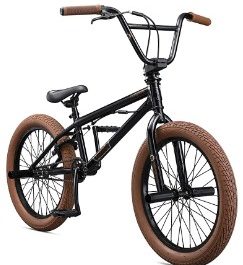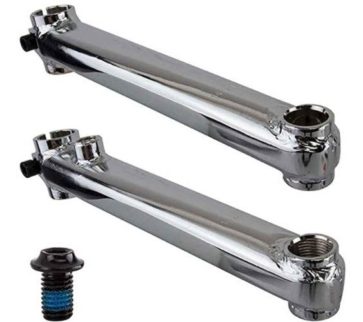BMX and mountain bikes are irrefutably close buddies in specs and components. So, it’s pretty tempting to want to swap or interchange their cranks. But can you put BMX cranks on a mountain bike?
Yes, one can fit a BMX crank on a mountain bike as long as the mountain bike’s spindle matches the inner diameter of the bottom bracket.
Let’s dig deeper to understand why you can put BMX cranks on a mountain bike!
Can You Put BMX Cranks On a Mountain Bike? – The Explanation
A bottom bracket is a component that connects the cranksets (chain sets in the UK) to the bicycle frame and allows rotation of the crankset independent of the structure.
It is made of a spindle, where the crankset attaches, and bearings that allow the spindle and the crankset to spin. The bottom bracket can be threaded or hydraulically pressed on the frame structure.
Bottom brackets commonly come in lengths of 68mm and 73mm. Other measurements are 83mm for downhill mountain bikes and 100mm for fat-tire bikes.
On the other hand, the spindle is the component that connects the cranksets to the bottom brackets. Spindles usually come in 19mm, 22mm, 24mm, and even 30mm. Most BMX cranks are either 19 or 22mm.
The bottom bracket that best allows for swapping a BMX crank onto a mountain bike is the Euro BB (British Bottom Bracket). Its inner diameter matches a spindle of either 19mm or 22mm.
Also, adapters enable the 19, 22, or 24mm spindle to fit onto the newer 30mm bottom brackets.
A word of caution. Mountain bike cranks are generally shorter compared with some BMX cranks.
Reason? Shorter cranks put less load on muscles and joints.
Less load and pressure on the joints means no pain on the hips, back, knees, and other body parts while you ride. Due to that difference in length, one should shim the chain line for optimal performance.
Now that you know it’s possible to put a BMX crank on a mountain bike, you might probably be wondering why anyone would consider BMX cranks on a mountain bike. Below are four reasons why.
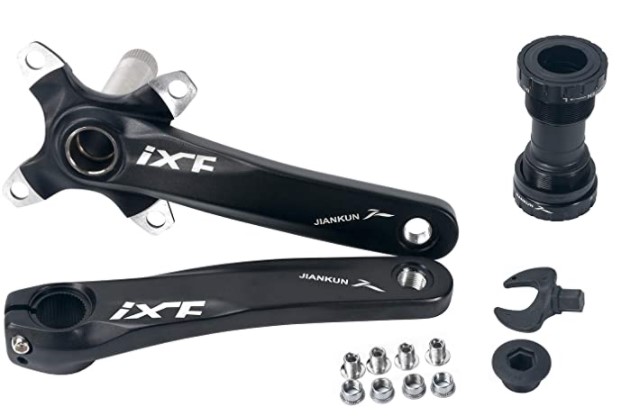
Why BMX Cranks Can Work On a Mountain Bike – 4 Reasons Explained
Here are reasons why BMX cranks can work on MTBs:
1. BMX Cranks Come in Various Lengths
The mountain bike industry maintains a standard of 175mm for crank arms. BMX cranks come in a variety of lengths. The lengths range is 170mm – 175mm. Reason?
Specific crank lengths perform better for specific BMXing disciplines. Crank arm lengths of 170mm or shorter work well for BMX flatland or street riding.
Crank arm lengths of 175mm or more best suit BMX racing or jumping. So, if you decide to take your MTB to the park, using BMX cranks is guaranteed to help your course.
2. BMX Cranks Are Durable
It is an open secret that BMX biking is an extreme sport. So everything in the BMX bike is made with durability in mind – the cranks included. BMX cranks are made from steel or alloys such as Chromoly.
The material of choice for a crank is vital to ensure crank arm strength. Ideally, a well-maintained crank should outlast even the frame.
Some manufacturers give a lifetime warranty for their cranks. That is a testament to how durable the cranks are.
For serious riders, though, it is recommended that they change their cranks after hitting 5,400 miles of riding.
3. BMX Cranks Weigh Less
The alloys used to make BMX cranks allow them to have the required structural integrity and yet weigh less. Some BMX cranks weigh about 2 pounds or less.
Knowing why you need BMX cranks and knowing which type to get are two different things. So, how many types of cranks are there? What are the pros and cons of each type?
2-Piece Vs. 3-Piece Cranks – Which Design Should You Choose for Your Mountain Bike?
Generally, there are three types of crank design – four if you count the 2.5-piece cranks. But, you might have noticed from the subheading that we’ve jumped straight to either 2-piece or 3-piece cranks.
Well, that is because 1-piece cranks are mainly found in retro bikes, children’s bikes, and low-quality bikes. So, unless you’re rebuilding your retro bike, you should avoid the 1-piece cranks.
They break down quickly and are not compatible with most modern bottom brackets available in the market.
The 2.5-piece crank, on the other hand, comes with the spindle attached to one of the arms by a removable wedge system. The 2.5-piece allows one to enjoy the benefits of both the 2-piece and the 3-piece.
2-Piece Cranks
They come with the spindle permanently welded or machine-pressed onto the drive-side crank.
2-Piece Cranks Pros
These cranks are easy to install. All you have to do is insert the sprocket, push the crank through the bottom bracket and fit the second crank on the other end.
There’s less maintenance on the 2-piece crank. Since one crank arm is welded in place, all you need to think about is the single bolt for the one remaining crank arm.
Most 2-piece cranks weigh less compared with the 3-piece ones. The spindles weigh less because they are hollow. The cranks have a wider diameter to make them stronger.
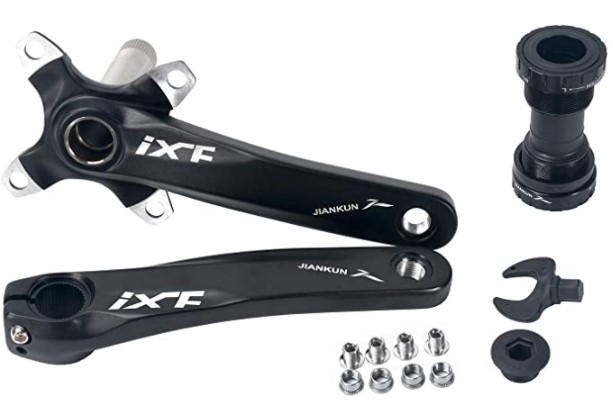
2-Piece Cranks Cons
Although cranks are built to last, they do break sometimes. If the spindle of a 2-piece crank malfunctions or breaks, it has to be replaced with a completely new set.
2-piece cranks cost more. They are also more challenging to get since they’re not the standard for cranks
The 3-Piece Cranks
3-piece cranks, the standard for modern cranks, have the spindle and both crank arms separate.
3-Piece Cranks Pros
These cranks are strong. They can handle all the abuse sent their way. So if you keep busting cranks, then the 3-piece is the way to go.
3-piece cranks provide compatibility. The rider is not confined to left or right-side drive.
These cranks are popular and offer variety. Due to their popularity and availability in the market, they’re less expensive than their 2-piece counterparts.
Since 3-piece cranks come in segmented pieces, replacing damaged parts is more manageable. You only need to replace the faulty part, and that’s it.
3-Piece Cranks Cons
For those conscious of bicycle component weight, it’s worth noting that some of these crank types weigh marginally more than the 2-piece cranks.
From the preceding, if all you need from a crank is simplicity and less weight, then you should go for the 2-piece crank. However, if you need a widely available modular crank, you should go for the 3-piece.
Best BMX Cranks for Mountain Bike
Below is a list of some of the best BMX cranks available.
1. ODYSSEY ODY Thunderbolt Crank Arm
The tried and tested right-hand drive 2-piece Odyssey crank is up there among the most advanced. It features a Never-Wobble crank, 22mm thick machine-pressed arm with improved graphics and fatigue life. Its steel colorway means you never have to worry about rust.
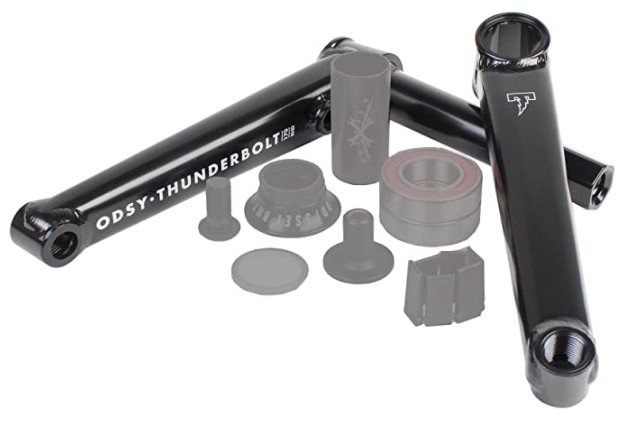
2. SE Bikes BMX RAD CROMO Crank Arm Set
For anyone that wants to make a switch from their stock cranks, this Chromo 3-piece crank is the perfect fit.
People Also Ask
Can I Put A BMX Crank On a Mountain Bike?
It is possible to fit a BMX crank on a mountain bike. However, the inner diameter of the bottom bracket must match that of the mountain bike’s spindle.
BMX Bike spindles usually have a diameter of either 19mm or 22mm. Mountain bikes, on the other hand, have 24mm thick spindles.
To fit the 19mm spindle, you’ll have to get a bottom bracket with a threaded body to match the mountain bike bottom bracket and a 19mm bearing at the front.
One can also use bottom bracket adapters while swapping cranks.
How to Put BMX Cranks On A MTB
You will need the following to execute a crank swap properly.
- A spanner or wrench to take out the pedals
- An Allen key (usually 8mm) to take out the cranks
- Grease
- A hammer, just in case something gets stuck
And now here’s how to go about installing BMX cranks on an MTB
- Flip your bike upside down.
- Use the spanner or wrench to remove the pedals.
- Loosen the cranks next. Cranks fasten using different methods depending on the manufacturer. Some cranks have a bolt that you can secure using an Allen key. Others have pinch nuts on the sides. Make sure to loosen these. For three-piece design cranks, remember to remove the bolt on the other side as well.
- Slide the loose crank off
- If you have a spline drive, slide off the sprocket that’s still attached to the axle. You will know it’s a spline drive if there’s no sprocket bolt to hold the sprocket in place.
- You can add or take away spacers depending on the dimensions of the new cranks. Please take a picture of the washers and spacers as they are before taking them out – unless you have a photographic memory. You shouldn’t have a problem if you’re replacing similar cranks.
- Once the cranks are out, check on the bearings. Replace if needed.
- Clean out the old grease and grime in the bottom bracket.
- Slide the sprocket back in, and then the crank arm. If you notice that it’s a bit hard sliding the crank arm in, gently use a hammer to nudge it in. Use the plastic or rubber side of the hammer to avoid damage to the crank. Some brands provide a sprocket tool to help with that.
- Make sure the crank arms align. To do that, use the seat post as a reference.
- Grease up the bolt and tighten the crank.
- Grease the pedals and put them back on. Don’t forget to place the chain back on.
Will BMX Cranks Fit MTB?
Yes, BMX cranks will fit a mountain bike if the threads on the inner part of the bottom bracket and the spindle match.
In Conclusion – Can You Put BMX Cranks On a Mountain Bike?
Generally, it is possible to fit BMX cranks on a mountain bike as long as the inner threads of the bottom bracket and the spindle match. Better yet, you can use bottom bracket adapters to enable you to execute a crank swap when there is a difference in diameter between the bottom bracket and the spindle.
Also Read:
